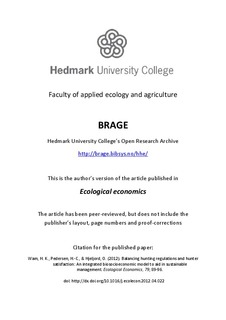Balancing hunting regulations and hunter satisfaction: An integrated biosocioeconomic model to aid in sustainable management
Journal article, Peer reviewed
Permanent lenke
http://hdl.handle.net/11250/134496Utgivelsesdato
2012Metadata
Vis full innførselSamlinger
Originalversjon
Wam, H. K., Pedersen, H.-C., & Hjeljord, O. (2012). Balancing hunting regulations and hunter satisfaction: An integrated biosocioeconomic model to aid in sustainable management. Ecological Economics, 79, 89-96. doi: http://dx.doi.org10.1016/j.ecolecon.2012.04.022 10.1016/j.ecolecon.2012.04.022Sammendrag
Hunting of game animals needs to be regulated, either through the number of permits or the bag size allowed per hunter. Such regulations may, however, jeopardize hunter satisfaction, on which game managers depend. Consequently, finding the optimal hunting intensity is not straightforward. Using data from Norwegian grouse hunting, we show that an integrated approach combining sociology and bioeconomics can give markedly different priorities than an optimization based exclusively on bioeconomics. Three grouse hunter typologies with contrasting stated preferences regarding bag size and crowding were used to account for varying hunter behavior. Omitting the social constructs from the model pushed the hunter density towards its upper limit, because the gain of selling one more permit generally superseded the loss in hunter satisfaction (expressed as willingness-to-pay). Although this strategy multiplied the overall profit, it produced a daily bag size that would be unacceptable to practically all hunters. We conclude that biosocioeconomic modeling is a valuable tool in the pursuit of sustainable game management.
Beskrivelse
This is the postprint version of the article. The published version can be found at the journal's webpage
